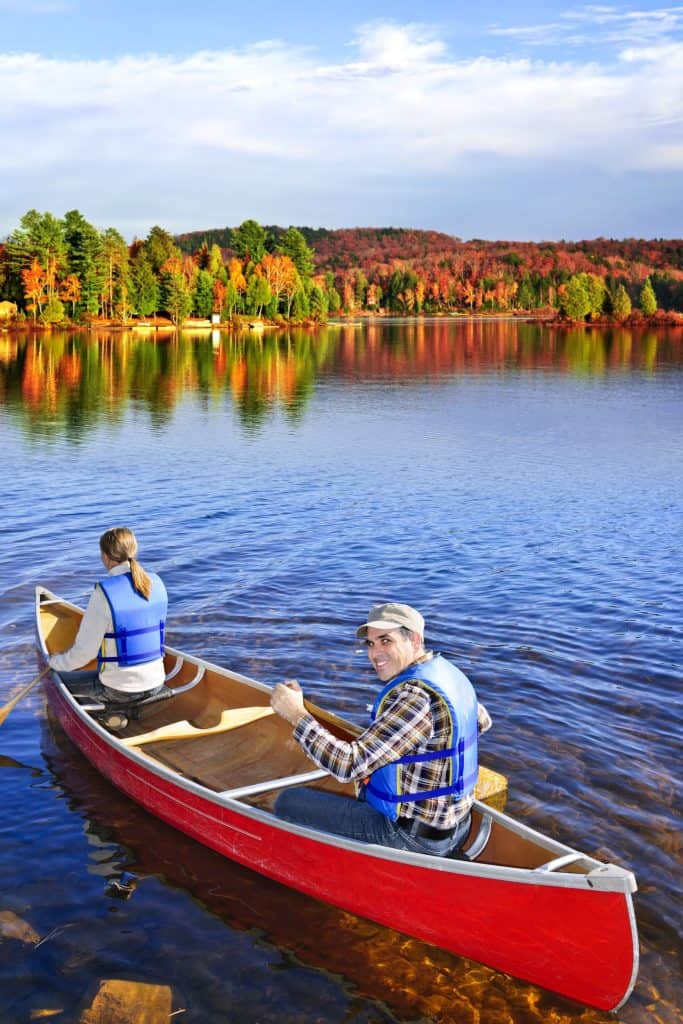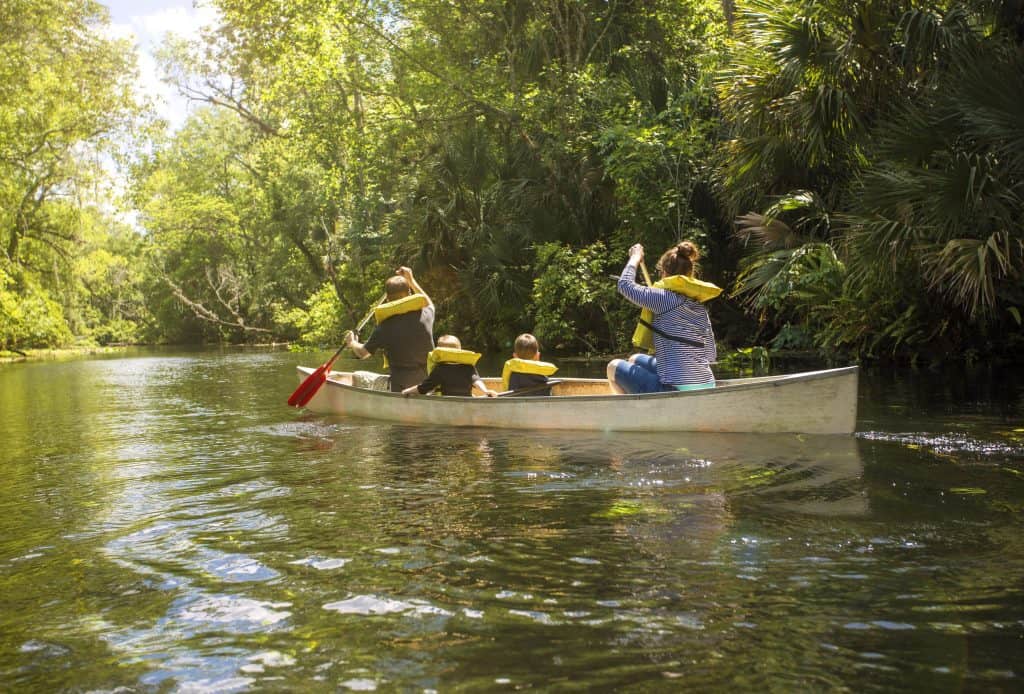
Planning a vacation to a lake for the summer means canoeing almost all the time. And of course, everyone wants to look cool while paddling up and down the river. If you don’t know how to steer that cool image flies right out of the canoe and into the lake. So before stepping into that canoe, let’s learn how to steer!
Steps to Canoe Steering
Step One: Establish Responsibility
Before canoeing, always make sure that each person knows what they are doing. In a two-person canoe, the paddler in the bow (front) of the canoe controls more of the power and speed of the canoe. The stern (back) paddler controls more of the directions of the canoe.
Usually the stern paddler is one with more stamina, although positions can often be switched. Either way, make sure each person is comfortable with the position they have. The trick is being efficient because efficiency works the best.
Related Reading: How to Get Into a Canoe
Step Two: Get Into Position
Once in the allotted positions, the lake will be yours for the taking. Make sure the canoe is in deep enough water that it won’t be dragging and scaping on the rocks at the bottom. Usually, 2.5 feet is more than enough water depth.
If you are by yourself, sit towards the middle of the canoe. If there is two people, one person should sit at the stern and the other on the front, just like mentioned above.
Grab the paddle and make sure that the dominant hand is located on the throat of the paddle. This is where the shaft of the paddle meets the blade. Basically, this means that your dominant hand should be placed right above the flat part of the paddle that goes into the water.
With the other hand grab onto the grip. The grip of the paddle is at the very top, and usually, make a T shape. Your hand should completely cover the grip.
If you’re not sure about the positioning of your hands, lift the paddle into the air and over your head. The placement of your hands and arms should create two 90 degree angles.
Throughout the trip, you will switch sides a lot, which means switching the positions of the hands will happen. As long as the position remains the same, it is still correct. For more help, check out this video!
The blade of the paddle needs to go all the way into the water. Paddling requires force. When you are in your canoe, the whole upper half of your body should be engaged in the paddling.
As both paddlers begin, make sure that the stern paddler is paddling on one side and the bow paddler is paddling on the other. Make sure that when sides are switched that both paddlers are aware of the side change.
This will keep you going in a straight direction instead of spinning in circles.
Step Three: Try Out Basics Like Steering and Trailing
Both paddlers should develop a cadence and should sync up quickly. To make sure your canoe is going straight, both paddlers need to be aware of what side the other paddler is on so they can do the exact opposite.
After a while, paddling should become almost second nature.
Paddlers should be sticking the paddle in the water next to the boat on the side they need to, and should be trailing the paddle back towards themselves. Trailing refers to dragging the paddle back towards the paddler.
Step Four: Use Paddles on Both Sides to Brake
Braking in a canoe is so simple it seems unreal. All that has to be done is for both paddlers, at the same time, to place their paddles straight down in the water. That’s it!
Don’t move the paddle unless steering is required. The paddle should stay flat in the water the push back against the water and slow the speed of the canoe.
Side Note: This must be done with both paddlers! If only one paddler is braking, it makes little to no difference to the speed of the canoe.
Step Five: Experiment with Braking Before You Get to the Shore
Reversing starts out just like braking, and remember synchronization is crucial!
Paddlers should place the paddles straight down in the water once more, but instead of keeping the paddle still, you push it back against the water.
Paddlers should no longer be doing a forward stroke. Instead of trailing the paddle back towards themselves, paddlers should be pushing the, instead of pulling, the paddle away from them.
Step Six: Try Turning Left and Right
When both paddlers want the canoe to turn right, the stern paddler should stick the paddle far ahead of the stern on the right side and trail the paddle back towards the stern.
If both paddlers want to turn the canoe left, repeat the same steps, placing the paddle ahead of you on the left side and trailing it back towards the stern, but on the left side.
Of course, sometimes the stern paddler might use great force and go to far to the left or the right. For minor corrections, paddlers can use the “J” Stroke.
The “J” stroke is very simple. As the paddle has been placed in the water straight down it pushes water behind the canoe. If a slight direction mishap has occurred, place the paddle in the water as you would normally, but at the end of the trail when the paddle reaches the stern again flip the paddle up, making a J shape.
The paddle should now look like it is trying to cut through the water instead of pushing it behind. Do not keep the “J” shape long. This is just like regular paddling! You want to keep pushing the canoe forward as you go.
For major corrections, the paddler might have to switch sides so that the canoe straightens out again, before turning the direction the paddlers need it to go.
This is called a draw stroke. It simply means that the blade of the paddle should be pushing the water back in the direction the canoe needs to go. The paddle should be close to the right or left side of the canoe (whichever direction the canoe needs to turn) and trailing it back towards the paddler.
Related Reading: How to Paddle a Canoe Solo? (Without Going in Circles)
Step Seven: Communicate With Your Canoe Companion
Communication is essential and crucial for good canoers.
Without good communication, both paddlers will start to go in circles and once again lose that cool image. Paddlers will not be able to brake, turn, reverse, or even steer if they aren’t talking to one another.
Remember that while the stern paddler can see exactly what the bow paddler is doing, the bow paddler can’t be constantly looking behind to check on what the stern paddler is doing.
Communication keeps you moving forward, and essentially having the most fun.
Avoid getting frustrated because it will tire you out quickly It is simply about talking and moving together, and yes it does take work!
Make sure that both paddlers are comfortable with communicating and understanding the needs of the other and canoeing will be a blast!

Step Eight: Avoid Fatigue
Even canoeing properly can get exhausting. Plan out a trip beforehand and make sure that both paddlers will have time to rest. Paddling requires a lot of strength and fatigue will eventually sink in. As long as both canoers plan on resting and rebuilding strength, the trip will be smooth and fun!
Sometimes stern paddlers will get fatigued faster than bow paddlers because they are mainly steering the canoe.
If at any point either paddler feels like positions need to be switched, pull over onto a shore and switch positions. This helps even out fatigue so one paddler is not more tired than the other.
Always remember that practice makes perfect! Before planning a huge canoeing trip, make sure that both paddlers feel confident in their canoeing abilities. Synchronization can be practiced on land!
Check communication and practice more by sitting in a canoe on land. Although this may seem weird and even look a little silly, both paddlers will be able to work together to steer, switch paddles, and communicate this way.
In the end, it is not just about being good canoers, it is about being safe.
Visit Our Canoe Page For More Great Content
Take the proper precautions before canoeing. Be well rested, and alert, pack high protein snack and food and lots and lots of water! Wear sunscreen and life jackets. Sometimes helmets will be necessary as well. Canoeing is much more fun when safety has been taken into account first!
